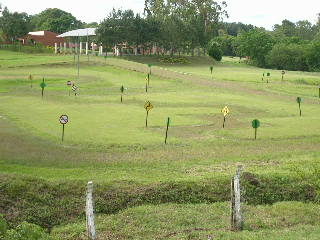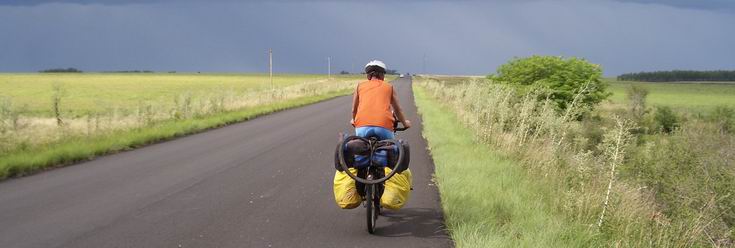|
Nov.
22 – Dec. 21 Foz
do Iguacu (Brazil) – Ciudad del Este – Encarnación (Paraguay) –
Posadas – Oberá –Sto. Tomé (Argentina) – Sao Borja –
Uruguayana (Brazil) - Bella Unión – Salto – Paysandú – Colonia
(Uruguay) |
|
| At Foz do Iguacu, three countries meet – Brazil, Argentina and Paraguay. The route we chose south took in all three, as we followed the Paraná and Uruguay rivers. | |
|
|
|
|
From Foz do Iguacu we crossed the friendship bridge to Ciudad del Este. This city, renowned as a duty-free port, is a chaotic smugglers paradise. For 200km on the Brazilian side of the border, there wasn’t a camera to be found on sale, as they just couldn’t compete with the Paraguayan prices. The bridge gives way to a crazy commotion of hundreds of motor bikes, cars, minibuses and trucks all scrambling to gain a position on the two-lane main drag. In between, tens of pedestrians laiden down with Santa Claus style sacks of purchases queue at the border post. The main street itself is an open air market of stalls, selling everything from socks and camping chairs, plastic boobs and stethoscopes to the ordinary boot leg CDs and DVDs. These stalls are backed up with high rise electrical and clothing stores with all the latest mod cons at rock bottom prices. As if this isn’t enough, the foot paths between the market and the shops are full of peddlers selling what you always needed, but never knew! |
|
|
|
|
| Having survived this mad town that comes to life at 4am, we proceeded south towards Encarnación. Our four days in Paraguay led us through countryside of soya, sunflowers, mate tea and grazing land. Darina shall remember Paraguay for its wolfwhistles and kisses – all bestowed by friendly truckies. Kurt shall remember Paraguay for its one-litre beer bottles and its miserable breakfast of cheap instant coffee and stale biscuits. | |
| Bright
and early one morning we bumped into four cyclists from Manchester doing
a three-month trip from Cusco, Peru to Rio de Janeiro, Brazil. |
|
| The
cultural highlight of our stint in Paraguay was the visit to the Jesuit
mission of Trinidad. One of 30 missions in the area of Argentina,
Paraguay and Brazil, it was set up in the seventeenth century to protect
the Guarani Indians from slave hunters and the influx of land grabbers.
Today the workshops, school, church and housing ruins are a grand
reminder of the biggest social experiment that happenend in South
America after white man arrived. |
|
|
|
|
|
Trinidad, Jesuit mission |
|
| The
culinary highlight of Paraguay was our stay at Bella Vista’s Papillon
Hotel, a third generation German resort with all the salads, sausages,
meats and deserts a European travelling in Paraguay would ever wish for.
|
|
|
|
|
|
Leaving
Paraguay was a breeze- on the back of a pick-up truck – as it is not
allowed to cycle across the bridge to Argentina. |
|
| We
were very lucky to meet Sergio and Nanci at the border who agreed to
carry us the 3.7km across the Paraná river. As it transpired, Nanci’s
brother Paco builds recumbent three-wheelers... and so before we knew
where we were, they had shuttled us off to his workshop. In the Misiones
district of Argentina, when someone stops you on the road, they don’t
just shake your hand, they invite you home, put you up and wine and dine
you. Sergio and Nanci did just that. We had a wonderful parillada, loads
of ice-cream and finished the weekend off drinking mate on the Costanera,
where half the town congregates to see and be seen, or rent Paco’s
bikes for a spin along the river. |
|
|
|
|
|
Sergio, Nanci and family in Posadas |
|
|
|
|
|
Paco and his recumbent trikes |
|
| From
Posadas, we took the Route 12 upriver to Santa Ana, another Jesuit
mission ruin. This was when we realised how polite and accommodating
Paraguayan and Brazilian truck and bus drivers really are. Having black
listed Singer Express bus drivers, we were told that their speedometers
are rigged by the company so that the drivers think they are doing
80kmph when in fact they are topping 140kmph. Not a surprising
revelation to two surviving cyclists. At Santa Ana we camped in an
idyllic spot by the river, with a private beach and not a soul in sight.
|
|
|
|
|
|
Beautiful camping at Santa Ana |
|
| En
route to Oberá, on one of our hottest and slowest days to date, we were
stopped by Hermann, a German deacon living with his wife Doris in
Misiones for 16 years. In true Misiones spirit, we ended up in his
visitors chalet for a few days of homely pampering and exercising of our
German language skills. |
|
| A
few more days of tobacco, mate and tea plantations led us to Santo Tome,
where we crossed another bridge, river and frontier to Brazil’s Rio
Grande do Sul province. This time round neither border post seemed too
worried about the fact that both the road and bridge were prohibited for
cyclists! |
|
|
|
|
| Tea plantations | Tobacco plantations |
|
|
|
| Following the Uruguay River on the Brazilian side brought us a change of scenery. Gone were the hills and the eucalypt plantations. Instead we cycled through bright green rice fields and grazing pastures. | |
| Wild life along
the road included the largest South American bird – the ñandú. This
flightless bird, looks like a minature ostrich (1.5m) and grazes
alongside cattle, sheep and horses. However it is a whole lot more
camera shy, and invariably legs it off into the great wide open when
either of us dismount our bikes. |
 |
|
|
|
|
Rice fields and colourful roadside bushes |
|
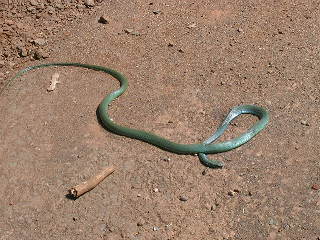
|
Suicidal guinea pigs are a little darker than your favourite pets and have a great urge to cross the road in front of two blue bicycles (successful) or in front of speeding trucks(...). Poisonous green snakes slither as long as they can while green lorikeets screech from telegraph poles with countless other exotic feathered friends. |
|
It’s
not all joy out there, but at least for this puncture we had the only
shade for miles around. To date, more than five months on the road, the
count stands at: Darina
- 4
punctures Kurt
- 2
punctures |
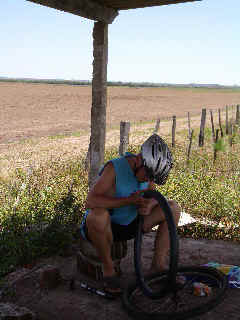 |
|
|
|
| However, if you happen to cycle along this stretch and a van pulls up, the chances are good that you’ll be presented with a delicious chilled honey-flavoured yoghurt by the friendly Sandro, delivery man. | |
|
|
|
| Gaucho country | |
|
Exiting
Brazil involved another bridge, but this time there were no federal
police on duty, so we had to saunter on to Uruguay without any exit
stamps in our pasports. |
|
|
|
|
| Free of foot and mouth disease, the cattle in Uruguay are full of the joys of the world and there is a strong border control by the Department of Argiculture on anyone arriving from Brazil. |
|
| Uruguay
started, the way Brazil ended, with a long stretch of nothing. 150km
later we arrived in Salto and were delighted to see old colonial houses
with decorative doors and stonework. Here we also had our introduction
to the mate cult. You’re only fully dressed in Uruguay with a thermos
flask under your arm and a mate (pronounced ma-tay) cup and straw
filter in your hand. Sucking this bitter infusion is a must when
driving, walking down the street, paddling in the river and even waiting
in the ladies. How do you recognise a Uruguayan with German ancestery?
He’s the one with the Pilsen beer bottle under his arm! |
|
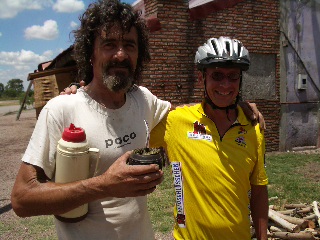 |
|
Friendly
folk in Salto Grande |
Uruguay's
Billy Connolly |
|
|
This stretch along the Uruguay river is famous for its hot springs. Even with air temperatures of 35 degrees Celcius, soaking in 39 degree springs is a treat for weary muscles and very relaxing. |
| Camping
possibilities abound and many river beaches and parks provide facilities
and shade for free. At weekends, it’s where everyone congregates to
have a parillada or barbeque with their mate... leaving it
all to us when the sun goes down. |
|
| Uruguay
may not be as well known as its two big neighbours – Brazil and
Argentina - but it has its
tourist industry and infastructure a whole lot better organised. Maps
and information leaflets are handed out by the ton with a friendly smile
and all the verbal explanations you might need. Our interior route, as
opposed to the Atlantic coastal one, was probably the quieter option,
but we met really friendly and genuine people everywhere we went. |
|
| Road
kill has become a whole lot more exotic of late and includes armadillos,
minks, parrots and snakes.
We can only provide pictorial evidence of the
same, but for the real experience: open the door of your fridge, dig out
that chicken dated 200BC and take a long, deep whiff. That should put
you in the picture ;-) |
|
|
An armadillo that didn't make it! |
|
|
|
Paysandu
provided another aspect of the not so pleasant fauna on the road. This
picture of a thatched farmhouse and barn, due to a recent mosquito
invasion, cost Darina no less then 37 bites... |
| One
of the wonderful features of Uruguay is it
abundance of old- timers, many dating back as far as the 1920s. At times
it’s like cycling through an old black and white movie set. |
|
| Roads in Uruguay are second to none... except for the 40km stretch from Dolores to Nueva Palmera. A bumpy patchwork quilt merged into a sandy, dirt track where oncoming trucks were a dusty, blinding experience. | |
| Presently,
we are enjoying the historical Portuguese fortress of Colonia de
Sacramento. Its traditional Porguguese and Spanish buildings,
cobblestone streets and riverfront ramblas make it a pleasant resting
spot. |
|
|
|
|
|
Views from Colonia de Sacramento |
|
| It’s from here that we would like to wish you all a very happy Christmas. It will probably be parillada and shorts for us... no turkey and pud in the snow this year! | |
|
|
|


